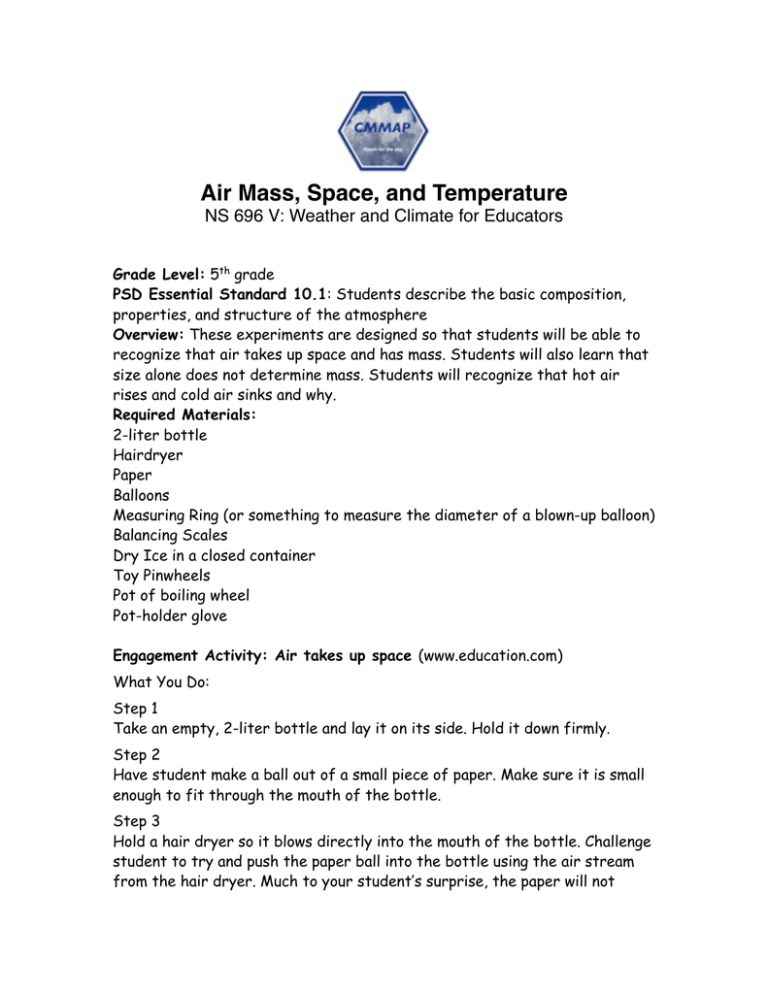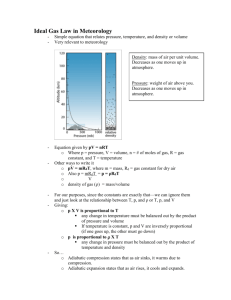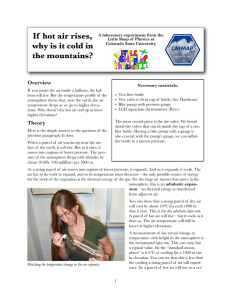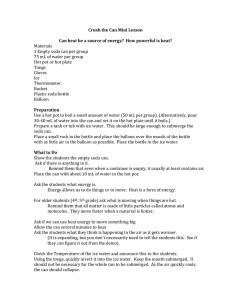Air Mass, Space, and Temperature
advertisement

Air Mass, Space, and Temperature NS 696 V: Weather and Climate for Educators Grade Level: 5th grade PSD Essential Standard 10.1: Students describe the basic composition, properties, and structure of the atmosphere Overview: These experiments are designed so that students will be able to recognize that air takes up space and has mass. Students will also learn that size alone does not determine mass. Students will recognize that hot air rises and cold air sinks and why. Required Materials: 2-liter bottle Hairdryer Paper Balloons Measuring Ring (or something to measure the diameter of a blown-up balloon) Balancing Scales Dry Ice in a closed container Toy Pinwheels Pot of boiling wheel Pot-holder glove Engagement Activity: Air takes up space (www.education.com) What You Do: Step 1 Take an empty, 2-liter bottle and lay it on its side. Hold it down firmly. Step 2 Have student make a ball out of a small piece of paper. Make sure it is small enough to fit through the mouth of the bottle. Step 3 Hold a hair dryer so it blows directly into the mouth of the bottle. Challenge student to try and push the paper ball into the bottle using the air stream from the hair dryer. Much to your student’s surprise, the paper will not enter the bottle even when the flow of air points directly to the bottle’s opening! Questions to ask the class: What Happened? Why couldn’t the student get the paper ball to enter the bottle? Explore Activity: Balancing Act (www.wviz.org) What you do: Step 1 Place an empty balloon onto each side of balance scale. Record what you notice (Balloons weigh the same). Step 2 Blow up one balloon, measuring it using the ring, and tie it off. Before placing the balloon back on the scale, record a hypothesis of what will happen (Inflated balloon weighs more). Have students explain why. Step 3 Blow up each balloon to same size, using measuring ring for accuracy. Tie off balloons. Before placing back onto the scale, record a hypothesis stating what you think will happen. Place a balloon on each end. Record what happens. (Balloons weigh the same) Step 4 Place one balloon into container of dry ice, closing lid on the container. After one minute, measure and record the size of the cold balloon (the balloon is smaller). Why did the temperature affect the size in balloon? Record a hypothesis for why the size of the balloon changed and what will happen once it is on the scale. Place the balloon on the scale and record what happens (Balloons still weigh about the same). Why is this? Explain: Theory for Engage activity: While student was trying to push the paper into the bottle, the air stream from the hair dryer was flowing directly at the mouth of the soda bottle. The hair dryer pushes air into the bottle, filling it with slightly compressed air. In fact, the bottle is so full of air that there is no room for anything else to enter - not even a little ball of paper! If they turn off the hair dryer or aim it away, the air can escape the bottle and there is room for the paper ball to enter. The activity illustrates the fact that air has volume. Theory for Explore activity: Weight and mass are different. Weight is a measurement of the effect of gravitational force on a mass. Mass is the amount of material in a sample. When the balloon was cooled, the air condensed, but the amount (or mass) did not change, therefore the balloons weighed the same. Extend: Why does hot air rise and cold air sink? Hot Air Pinwheel (www.scienceathome.com) What you do: Step 1 Have an adult boil a pot of water. Step 2 With an adult's help, wear a pot-holder glove and hold a toy pinwheel over the steam of the boiling water. Observe what happens to the pinwheel. Step 3 Now move the pinwheel away from the steam and see what happens. Theory: The heated air molecules from the steam move faster and farther apart. The air becomes lighter and rises upward creating an air current which moves the pinwheel. Hot Air: Air is made up of molecules that are constantly in motion. As air warms up, the molecules start to vibrate and bump into each other, increasing the space around each molecule. Because each molecule uses more space for motion, the air expands and becomes less dense (lighter). In other words, the same number of air molecules occupy a larger space or the same sized space with increased air pressure. Cold Air: The opposite effect happens when air cools. As the temperature drops, molecules move more slowly, taking up less room. The amount of space the air takes up shrinks, or reduces the air pressure. Why does hot air rise? Warm air rises, and when it rises it becomes cooler. That information is key to understanding a lot of meteorology (science of weather). Rising air experiences a drop in temperature, even though no heat is lost to the outside. The drop in temperature is a result of the decrease in atmospheric pressure at higher altitudes. If the pressure of the surrounding air is reduced, then the rising air parcel will expand. The molecules of air are doing work as they expand. This will affect the parcel's temperature (which is the average kinetic energy of the molecules in the air parcel). One of the results of the Laws of Thermodynamics is that there is an inverse relationship between the volume of an air parcel and its temperature. During either expansion or compression, the total amount of energy in the parcel remains the same (none is added or lost). The energy can either be used to do the work of expansion, or to maintain the temperature of the parcel, but it can't be used for both. If the total amount of heat in a parcel of air is held constant (no heat is added or released), then when the parcel expands, its temperature drops. When the parcel is compressed, its temperature rises. In the atmosphere, if the parcel of air were forced to descend, it would warm up again without taking heat from the outside. This is called adiabatic heating and cooling, and the term adiabatic implies a change in temperature of the parcel of air without gain or loss of heat from outside the air parcel. Adiabatic processes are very important in the atmosphere, and adiabatic cooling of rising air is the dominant cause of cloud formation. Evaluation: Students will be tested on the following key points/questions: 1.) Does air have mass? 2.) How does size effect mass? 3.) Why does hot air rise? 4.) Why does cold air sink? Lesson generated by Elizabeth Rigby







